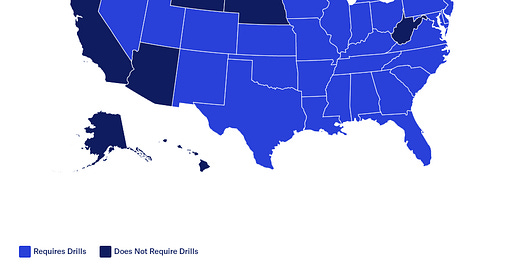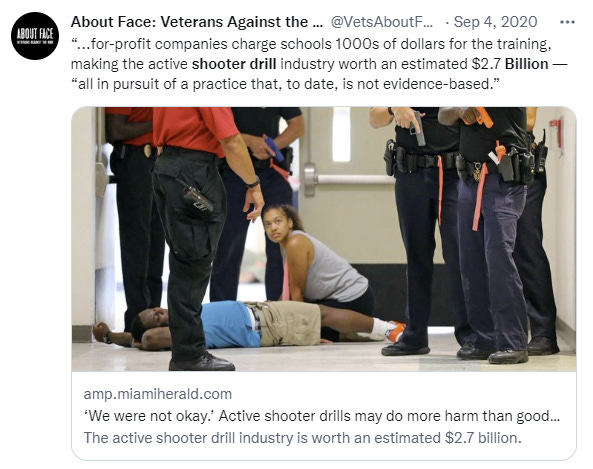Epistemic Status: You really, really should know this already. Reference post.
We have a $2.7 billion industry devoted to causing the traumatization of children.
They refer to it as ‘active shooter drill training.’
I was initially motivated to write this when I saw a claim that the bipartisan gun deal allocated $5 billion in additional funding for causing childhood trauma. That turned out not to be the case (summaries of the deal from NPR, from CNN and from WaPo don’t mention it and it seems too big to have been overlooked if it was real), but these shooter drills are still traumatizing our children on a regular basis, which seems worth pointing out as another prime example of both our civilization losing its mind and also the existence of extremely low-hanging fruit.
As in, we could simply not traumatize our kids all the time for no reason. Crazy, I know.
For those who don’t know, an ‘active shooter drill’ is where they take young children who are forced by law to be at a given location each day, and periodically teach have them practice hiding and being shot at by a mass shooter.
If your response to that idea is ‘what, what, that sounds horrible and terrifying and we should absolutely positively not do that’ then you seem like a normal human to me.
If your response to that idea is ‘yes this will help protect our children’ then I do not understand you.
Yet these drills are required. Since school is also required, this is something the state is forcing on children. Children are being forced to report periodically for trauma.
This is so much worse than wasted time. If I am told that one of my children is going to have such a drill, I will keep my child home from school that day, this seems like what a parent who cares about their child would do.
If the school does not consider this an acceptable solution, I will pull them out of that school entirely. It’s not only a one-time thing, they think this is an important thing that they practice continuously.
All the replies are like this, of parents reporting children coming back from drills terrified. I have tried to argue against Gain of Function research and against constructing an unfriendly AGI, and had to talk various players out of some truly epically bad deck choices, but I have never, ever seen anything like as clear a case of something you absolutely positively and obviously should not be doing.
This Washington Post article has a variety of reactions to drills. Some of them are about how shameful it is that we have people shooting up schools in the first place, but mostly it’s about how these drills primary effect is clearly to traumatize students.
Yet this has ballooned into an industry, due to our demand to do something:
I do not need a study to say that this ‘may’ do more harm than good, and neither do you.
Once again, the problem of actual shootings is terrible but the magnitude is simply not that large. It (once again) bears keeping in mind the magnitude of the problem:
The database documents when a gun is brandished, a gun is fired, or a bullet hits K-12 school property for any reason, regardless of the number of victims, time of day, or day of week. There have been 1,322 individual shootings since the 1970s, resulting in 426 deaths and 1,225 injuries.
Or, alternatively, there is one live shooting incident in a given school every 6,000 years, with an average of less than one death out of an average school size of slightly more than 500 students.
Even if active shooter drills were 100% effective at preventing deaths from school shootings, as opposed to being useless or (more likely) highly actively counterproductive even on that front, it would still be completely criminally insane to subject kids to this kind of trauma.
The Study
For those who do not believe that evidence exists unless it comes in the form of a study or report, or who want to know exactly how much damage is being done here, the good news is we do have a study and a report on the study. The bad news is, well, the report’s contents. And also the study’s contents.
Not that it is entirely news, but the magnitude of the impact is I suppose news.
The results were sobering: Active shooter drills in schools are associated with increases in depression (39%), stress and anxiety (42%), and physiological health problems (23%) overall, including children from as young as five years old up to high schoolers, their parents, and teachers. Concerns over death increased by 22 percent, with words like blood, pain, clinics, and pills becoming a consistent feature of social media posts in school communities in the 90 days after a school drill.
In particular:
Using machine-learning psychological affect classifiers informed by prior research, this study aggregated and analyzed the sentiments expressed through millions of tweets and more than 1,000 Reddit posts. Results revealed that social media posts displayed a 42 percent increase in anxiety and stress from pre- to post-drills (as evidenced by an increase in such words as afraid, struggling, and nervous) and a 39 percent increase in depression (evidenced by words such as therapy, cope, irritability, suicidal) following drills.
…
This research unveiled alarming impacts of active shooter drills on the mental health of the students, teachers, and parents who experience them. In their current state, active shooter drills threaten the wellbeing of entire school communities over prolonged periods of time, leaving those who are affected in need of continued support to process their aftermath.
…
This study suggests that physical health may be significantly impacted by active shooter drills in schools as well. In the 90 days following a drill, concerns over health increased by 23 percent and concerns over death increased by 22 percent. The analysis revealed words like blood, pain, clinics, and pills came up with jarring frequency, suggesting that drills may have a direct impact on participants’ physical health or, at the very least, made it a persistent topic of concern.
This isn’t the methodology we would have hoped for, but it is the one we have and the results very much qualify under the ‘hot damn look at this chart’ test.
We get typical quotes like this:
I can tell you personally, just as an educator, we were not okay [after drills]. We were in bathrooms crying, shaking, not sleeping for months. The consensus from my friends and peers is that we are not okay.”
K–12 teacher
or:
“[After drills, kids] think a villain is coming to school and wonder when it’s happening, not if it’s happening”
K–12 parent
As usual, somehow the conclusion is unwilling to quite come out and say the obvious.
In the absence of any conclusive evidence on drills’ effectiveness at ensuring safety during actual active shooter incidents, Everytown urges school decisionmakers to assess whether the potential but unproven benefits of these drills outweigh their known collateral consequences.
This is still madness. What is the maximum potential upside here? Again, it certainly can’t be more than 100% prevention of school shootings, and we know it is much much less than that.
In light of this study’s findings, Everytown strongly encourages school systems to prioritize these proven school safety strategies above active shooter drills.
…
Comprehensive school safety plans require far more than periodic active shooter drills.
Prioritize other measures over traumatizing children? Requires ‘far more than’? This is a report that lays out in detail how traumatizing drills are for kids, notes their benefits are entirely unproven (and of course, couldn’t possibly make up for this) and then urge prioritization?
We must do something.
This is something.
Therefore we must do it.
No. We mustn’t. I’d also rather we not deploy drones.
They go on to say, if you must traumatize your kids, how about traumatizing them less efficiently via these recommendations:
Drills should not include simulations that mimic an actual incident;
Parents should have advance notice of drills;
Drills should be announced to students and educators prior to the start;
Schools should create age and developmentally appropriate drill content with the involvement of school personnel, including school-based mental health professionals;
Schools should couple drills with trauma-informed approaches to address students’ wellbeing both during the drills, and over a sustained period thereafter; and
Schools should track data about the efficacy and effects of drills.
So if you are determined to traumatize children, you should then spend tons of time dealing with the trauma you’ve caused, involve extensive materials related to mental health professionals, and provide notice of the trauma to come, and track the effects.
So, I mean, yeah, I guess if I had no choice but to traumatize children I would do that?
One particular thing that was sometimes done was to have pretend gunmen roaming the halls firing blanks. I think we mostly realized not to do that.
There are also additional reasons to think drills are even worse than this.
Drills teach children that they live in a world where deadly school shootings are are something they should expect to happen in their lives, which they aren’t. This functions to put the idea of shooting up a school closer to top of mind and to normalize it as a choice. It lets disturbed kids at risk of doing this see what it would look like, and maybe discover they like it, or that other kids deserve it.
I propose that traumatized kids, kids who despise their schools for damn good reason, or those who are constantly among others with trauma, are going to more often choose to do crazy horrible things like shoot up the school.
Drills show potential shooters exactly how everyone will react. This alone plausibly allows them to plan the most effective response measures in ways that more than nullify any benefits from the drill.
Drills teach children exactly how much the system and the adults around them care about them. They’ll respond accordingly.
Drills, preparing for drills, dealing with the aftermath of drills and all the resulting focus on such matters takes a lot of time away from learning, to the extent that was a thing school was trying to do.
What to do about this?
On a civilization level, we should stop doing this. At minimum we should do less traumatic versions of it, ideally stop causing trauma for no reason. I’m an idealist.
On a personal level, you should do a few things.
Ensure that any schools you send your children to are informed about how terrible all of this is. They may or may not be permitted to stop or make changes, but it’s worth a shot.
Ensure all relevant authority figures at all levels also know how terrible this is and how much you oppose this.
Ask when the drills are. Keep your children out of school on those days.
If they won’t tell you when the drills are, ideally figure it out, things that look random often aren’t.
If you can’t figure it out at all, strongly consider your other educational options.
That last one sounds dramatic, but the effects here seem quite large and quite bad, and also likely to be indicative of other problems. If a school is run by people who are not willing to help me not traumatize my child, this is not where I want my child spending the bulk of their day. If they think it is necessary, this is not where I want my child learning to think or do mathematics.
I would extend this logic to the presence of police, or metal detectors, or any other militarization of a school. Any place where such measures are actually necessary is not a place to put children. Also, no, nothing involving doors will meaningfully help.
There are a variety of other approaches also being debated. I am not here taking any position on them either way. This is about avoiding the obviously horrible option.











"Schools should track data about the efficacy and effects of drills."
I wonder how exactly they expect to measure the "efficacy" of drills. As you rightly point out the probability of being involved in a shooting situation is vanishingly close to zero. So... what are they going to measure and compare? What kids do in subsequent drills?
The out and out lies the activists and politicians spread about school shootings have made people crazy. In the "entirely detached from reality" sense, that is; in a world where any school had a 5% chance of experiencing a mass shooting in a given year this might make sense, although at that point one should ask "why do we have these schools?"
I've been wondering for awhile if lockdown is even an optimal strategy for mitigating spree shooters.
As far as I can tell we do not practice lockdown anywhere except for schools. Workplaces, public places, there are no drills and no lockdown plans. If there is a shooting, most people will instinctually flee from the sound of gunfire. Excepting coordinated ambushes, or mistakenly fleeing into a dead end, that seems like a good, if not the best, strategy.
Guns have a limited effective range, and most spree shooters are not trained marksmen. Distance and shooting angles scale linearly. If you present a two foot wide target at 10 feet away the shooter can shoot within a 12 degree angle to hit the target. At 20 feet it's about 6 degrees. At 40 feet it's about 3 degrees. At 400 feet about 0.3 degrees. So, getting distance greatly decreases your chance of getting hit.
Locking yourself into a room is effectively fleeing into a dead end with a door. If the shooter breaches the door, you're very close and have nowhere to run. If the walls are penetrable a shooter could just fire through them and have a good chance of hitting targets. If the walls aren't penetrable, the shooter could still fire into windows from outside.
Where's the evidence that lockdowns are a good strategy? Is the thinking that it's too hard to get kids to run away? Have you met kids?